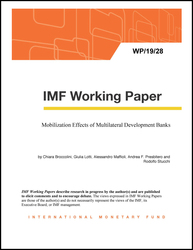
Mobilization Effects of Multilateral Development Banks
We use loan-level data on syndicated lending to a large sample of developing countries between 1993 and 2017 to estimate the mobilization effects of multilateral development banks (MDBs), controlling for a large set of fixed effects. We find evidence of positive and significant direct and indirect mobilization effects of multilateral lending on the number of deals and on the total size of bank inflows. The number of lending banks and the average maturity of syndicated loans also increase after MDB lending. These effects are present not only on impact, but they last up to three years and are not offset by a decline in bond financing. There is no evidence of anticipation effects and the results are not driven by confounding factors, such as the presence of large global banks, Chinese lending and aid flows. Finally, the economic effects are sizable, suggesting that MBDs can play a vital role to mobilize private sector financing to achieve the goals of the 2030 Development Agenda.
Publication date: February 2019
ISBN: 9781484393864
$18.00
Add to Cart by clicking price of the language and format you'd like to purchase
Available Languages and Formats
| English |
Prices in red indicate formats that are not yet available but are forthcoming.
Topics covered in this book
This title contains information about the following subjects.
Click on a subject if you would like to see other titles with the same subjects.
Multilateral Development Banks , Private Capital Flows , Mobilization Effects , Catalytic Finance , Syndicated loans , syndicated loan , MDB , outcome variable , mobilization , bond issuance
Summary
Copyright © 2010 - 2024
Powered by:
AIDC



